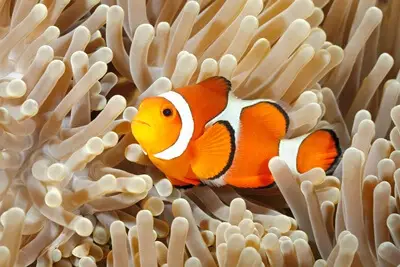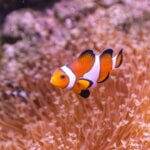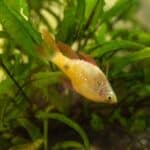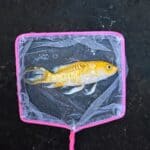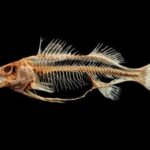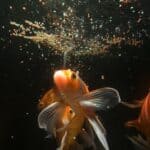Anemones and clownfish have a symbiotic relationship. If you own clownfish, you may want to pair them. Clownfish aren’t the easiest to raise, so you must choose carefully to ensure they like their new home.
Clownfish don’t need anemones, hosting whatever they see fit. Sometimes, they won’t host anything. The most popular are the bubble tip, Haddon’s saddleback/carpet, and beaded anemones.
Other options that clownfish like include magnificent, giant carpet, leathery, Merten’s carpet, Corkscrew, and Sebae anemones. These are found most naturally in the wild and pair well with clownfish.
There’s little rhyme or reason for how pet clownfish pick their anemones.
What Anemones Do Clownfish Like?
Clownfish like anemones due to their preferences. To avoid too much trial and error, begin with the anemones that clownfish species naturally host in the wild.
Your clownfish may still reject them. Clownfish are picky creatures, disliking the shape, color, size, movement, or random factors about the anemone.
After all, clownfish host mushrooms and corals. That makes it hard to determine their preferences.
Observe the clownfish’s behavior and see if it prefers to hide in certain areas. Then, look for anemones that resemble the hiding spot, perhaps in terms of:
- Color.
- Shape.
- Size.
This isn’t a surefire way to get the fish to like a new anemone.
What Kind Of Anemones Do Clownfish Live In?
Clownfish host many kinds of anemones. It depends on the species, but clownfish can adapt and host anemones they usually don’t. This is even more true for captive-raised clownfish.
Clownfish are known to host objects that aren’t anemones.
Expect clownfish to host anemones they naturally host in the wild. Also, note that some anemones won’t host clownfish. To maximize the likelihood of success, choose pairs that bond in the wild.
This chart lists the common pet species of clownfish and the anemones they host:
| Clownfish | Scientific name | Naturally Hosts |
| Ocellaris, False Percula | Amphiprion ocellaris | Magnificent, Giant Carpet |
| Percula, True Percula, Clown Anemonefish, Picasso | Amphiprion percula | Leathery, Magnificent, Giant Carpet, Merten’s Carpet |
| Red cinnamon, black cinnamon | Amphiprion melanopus | Bubble tip, Leathery sea |
| Leathery, Magnificent, Giant Carpet, Merten’s Carpet | Amphiprion clarkii | Leathery, Magnificent, Giant Carpet, Merten’s Carpet |
| Tomato, Red | Amphiprion frenatus | Bubble Tip, Leathery |
| Red Saddleback, Fire | Amphiprion ephippium | Bubble Tip, Leathery |
| Saddleback | Amphiprion polymnus | Leathery, Magnificent, Giant Carpet, Merten’s Carpet |
| Maroon, Spinecheek, White-Stripe, Gold Stripe | Premnas biaculeatus | Bubble tip, Corkscrew |
| Orange Skunk | Amphiprion sandaracinos | Leathery, Magnificent, Giant Carpet, Merten’s Carpet |
| Pink Skunk, Pink anemonefish | Amphiprion perideraion | Corkscrew, Magnificent, Leathery, Giant Carpet |
Which Anemone Is Best for Clownfish?
As pets, the anemone your clownfish hosts is less critical. Clownfish host anemones to protect themselves. In a peaceful and well-maintained tank, there’s little need for protection.
The best anemone for clownfish is whichever one it likes. You can try to get the clownfish to pick a specific anemone. However, the best anemone for it is whichever one it picks.
Of course, the anemone you pick will have its limitations. Anemones can be hard to raise, and some require special equipment and diets.
These half-plant, half-animal hybrids require significant care and attention. Some are also more readily available than others, which will also depend on where you live.
Before getting a clownfish to host an anemone, it must establish itself in the tank. Let a tank run for 6-8 months before adding an anemone. However, waiting an entire year is recommended.
Many anemones are large. If you want natural anemone matches, some are 3 feet in diameter. Otherwise, you can pick non-natural anemone matches, which are smaller and easier to care for.
Here are common species that are favored by clownfish:
Bubble Tip
The bubble tip is the easiest to keep, hosted by many species. Even those that don’t host them naturally can adapt to a bubble tip.
This anemone is relatively hardy and doesn’t require as many special requirements as other species. It’s also smaller, with a maximum size of about 1 foot.
Because it’s simpler to raise, you can find it in pet stores more commonly than other species. The bubble tip is attractive. If your fish doesn’t host bubble tip anemone, it won’t harm the tank.
Haddon’s Saddleback/Carpet
Also known as the carpet or saddle anemone, stichodactyla haddoni is among the most colorful anemones for hosting clownfish.
The saddleback is easy to raise, lacking onerous requirements other than high light levels.
This species would be just as easy to raise as the bubble tips were it not for its size. Haddon’s saddleback regularly reaches 2 feet across. The anemone is also highly aggressive when stinging.
If you’re careful about stings, it’s worth considering them for clownfish. You’ll need a large tank and ample lighting, but many clownfish species will settle in.
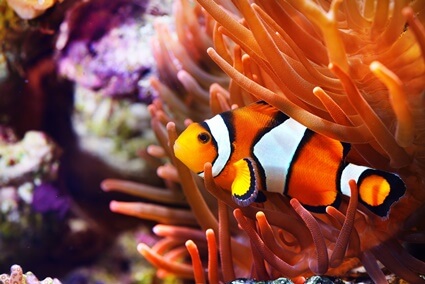
Beaded
If you want a subtle appearance, consider the beaded anemone. It’s also known as heteractis aurora or the aurora anemone. It earns its name because it resembles a string of grey pearls.
The beaded anemone is a good choice for novices because it’s hardy.
At least, that’s true when it’s given the right environment. The most challenging feature of this anemone is that it likes to move around. Otherwise, it’s relatively easy to care for.
Because of its subdued color, the beaded anemone sadly isn’t a favorite among clownfish. That’s especially so among common pet species.
An exception is Clark’s clownfish or A. clarkii, which prefers beaded anemones.
How To Get My Clownfish To Host Anemone
You’ve picked an anemone. Now, it’s time to encourage the clownfish to host it. This will depend on the fish, but there are ways to push the clownfish in the right direction.
Here are tips for getting a clownfish to host an anemone:
Scraper or Net
Start by nudging the clownfish with a scraper or a net to get closer to its anemone.
Don’t touch the anemone, or it’ll close up. The objective is to introduce the fish to its new home, similar to allowing land-based pets to smell each other.
Sometimes, it involves showing the fish the new anemone. If it refuses to host, use another tactic.
Tube Method
For the tube method, get an acrylic tube that will comfortably fit around your clownfish. It should be larger than the clownfish, allowing the fish to swim through comfortably.
Position the tube so that it ends just before the anemone. You don’t need it flush with the new home. If you touch the anemone, it’ll close up.
Place the tube close enough so the anemone is the first thing the clownfish sees when exiting. Ideally, the position will make it less likely to be distracted by other objects.
Once it’s positioned, place the fish on the other end of the tube. Give it time to swim to the other side, and let it explore the anemone independently.
Tape Up A Photograph
Tape a photograph to the side of the aquarium.
The photograph will depict a clownfish happily hosting an anemone. For better results, try picking a clownfish of the same species, matched to the same anemone you want yours to host.
This should teach the clownfish that the anemone is meant to be hosted. It could also work because the fish is scared about seeing another fish in its territory.
Add More Fish or Use A Mirror
Clownfish host anemones because they need protection from predators.
In a peaceful and regulated tank, they may not feel compelled to hunker down. Therefore, introducing risk (whether natural or manufactured) can urge the clownfish to play host.
This can be done by adding more fish. It may seem unkind, but an anemone should make the clownfish feel more comfortable.
You can add a mirror to the side of the tank. When the clownfish sees another fish (its reflection), it’ll become territorial. This encourages it to hide in an anemone.
Once the clownfish gets used to its home, remove the mirror.
Separate Both
When all else fails, separate the anemone and clownfish in an isolated tank. If the clownfish has nothing else, there’s a higher chance of hosting the anemone.
To do this, transfer the anemone first. Once it has established itself in the new tank, move the clownfish. Wait for the clownfish to host the new anemone for as long as the setup allows.
Do Clownfish Need Anemones?
Wild clownfish must host anemones to raise their chances of survival. Your fish don’t need one. Pet clownfish may host an anemone out of preference, assuming there’s nothing else in the tank.
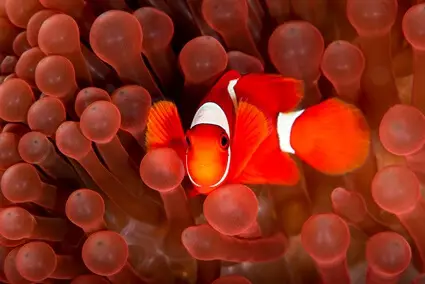
How Long Does It Take for Clownfish To Host Anemone?
You can expect clownfish to host an anemone in a couple of days and months.
Some clownfish may never take to the anemone you provide. There are things you can leverage to encourage a clownfish to like its new friend.
Some fish will utterly refuse and never bond with the anemone you want them to.
Why Do Clownfish Live In Anemones?
Clownfish and anemones are an iconic duo of marine life. Researchers and hobbyists alike have long marveled at how these two organisms cohabit.
The anemone and clownfish have a symbiotic relationship. This means they benefit from the bond.
Researchers believed this was a one-way benefit for many years, wherein only the clownfish earned protection. Recent studies illustrate that the bond is more complex.
Prevent Predators
Clownfish host anemones to hide away or protect against predators.
Anemones can sting predators. The clownfish, immune to its sting, can use the anemone to stay covered and escape attacks from diligent enemies.
In return, clownfish fight off the butterfly fish that eat the anemone.
Fertilizer
According to the Journal of Experimental Marine Biology and Ecology, the ammonia-rich poop of the clownfish is a fertilizer for the anemone. This enables it to feed and grow.
Clownfish increase the amount of nutrients anemones can eat. They do this by wriggling themselves through the anemone’s tentacles, increasing oxygen and water flow.
This behavior has also been observed on fish that host coral reefs, like gobies and damselfish.
The stronger and healthier the anemone, the more protection it can offer the clownfish.
Do Clownfish Like Fake Anemones?
Some clownfish like fake anemones, while others don’t.
It can be hard to predict how fish will react. Clownfish host things that aren’t anemones. From plastic decor to water filters, clownfish can make a home almost anywhere.
Artificial anemones are often made from rubber or latex. When placed in a tank, they look just like the real thing. This can be a good alternative if your clownfish refuses anemones.
Fake anemones can also be easier to manage for beginner aquarists. Real ones often require pristine water conditions and particular feeding needs.
Moreover, they can’t survive in a tank that hasn’t been established for at least 6 months. For beginner aquarists and new tanks, turn to anemone alternatives, like fake ones or corals.

